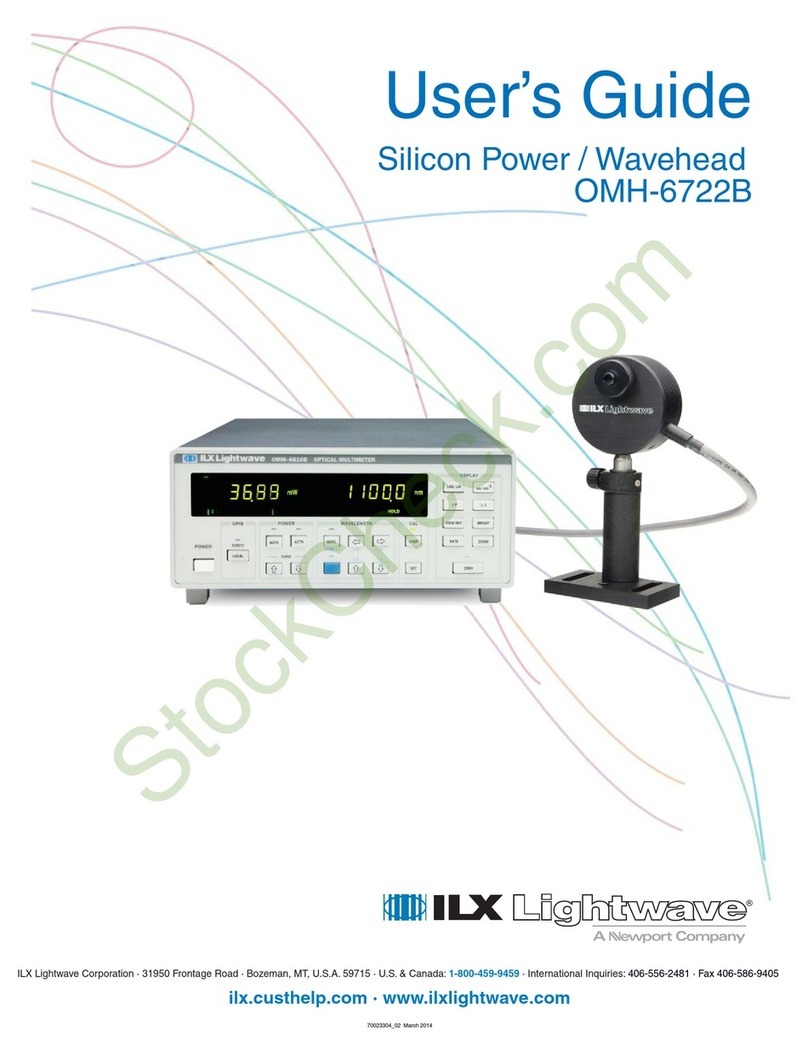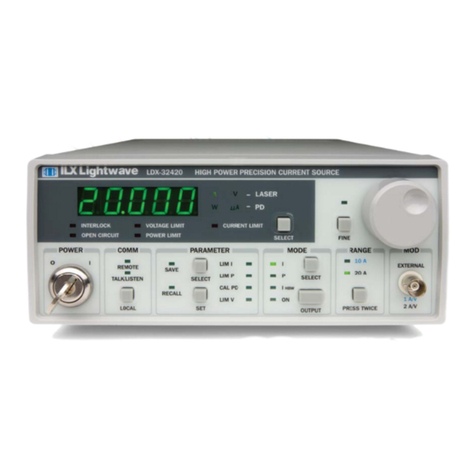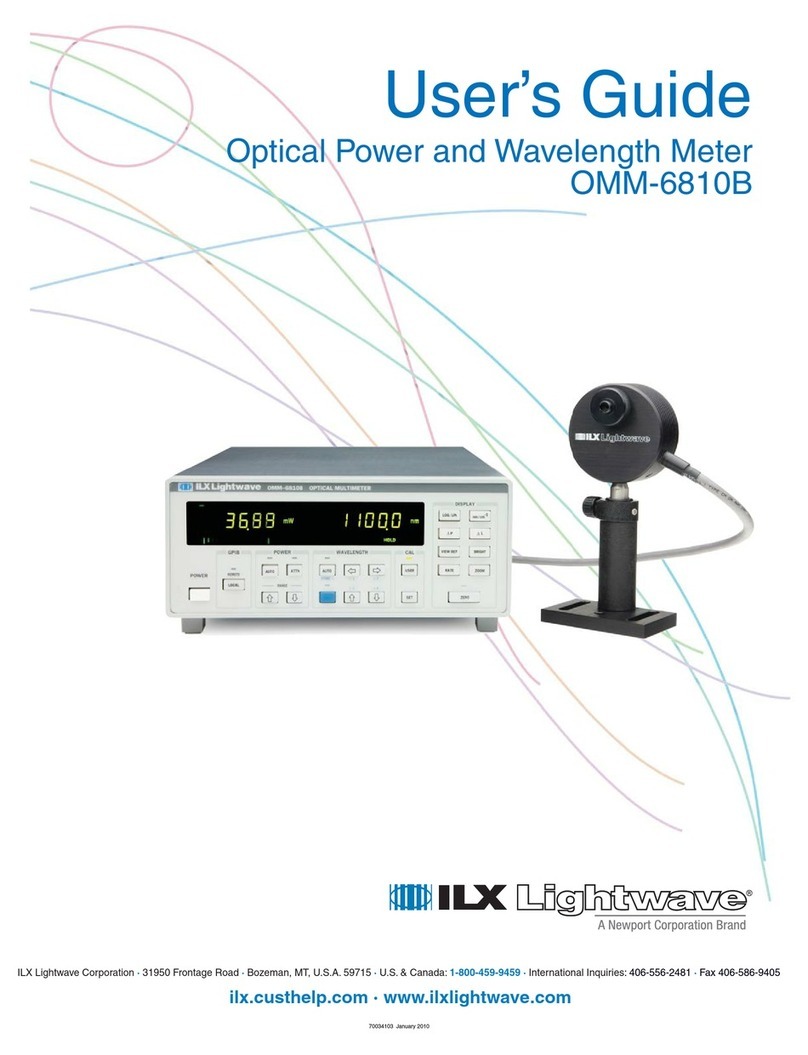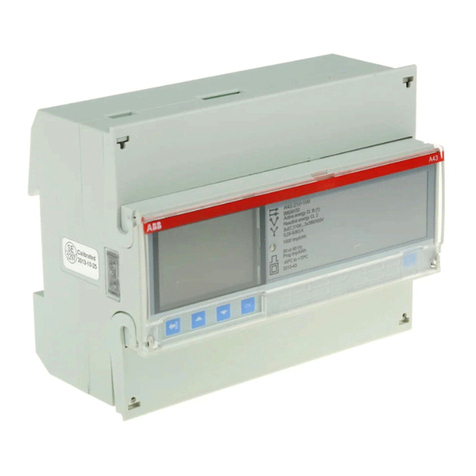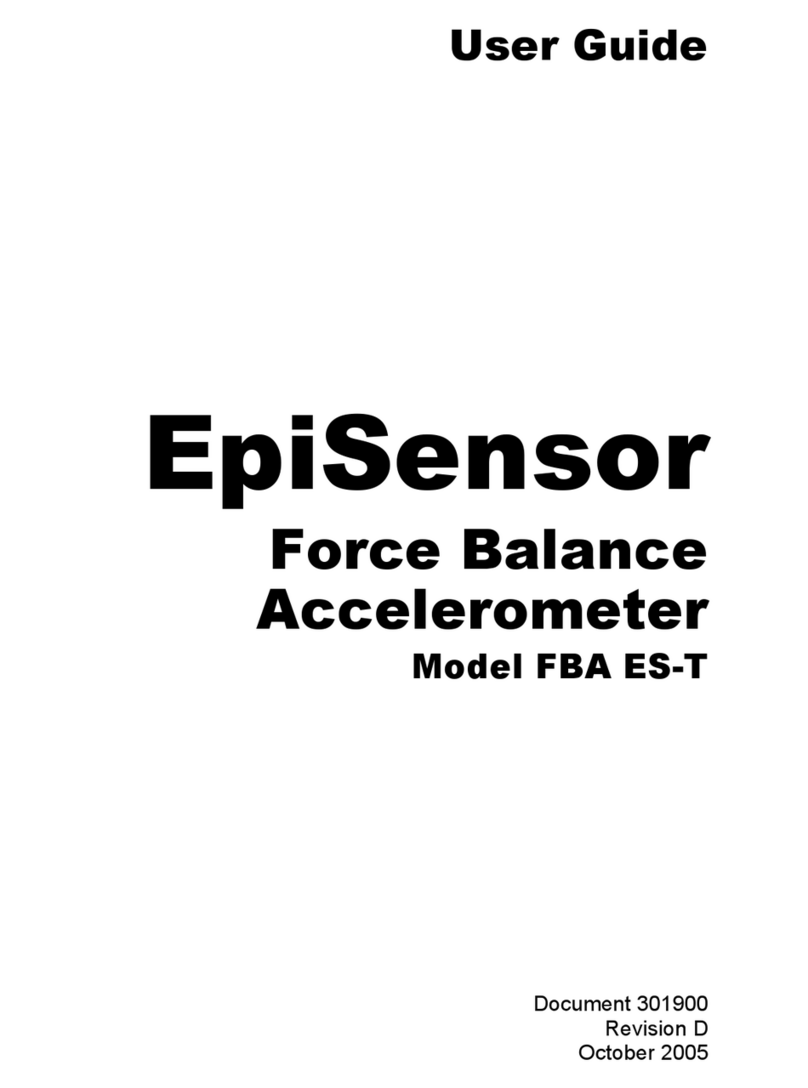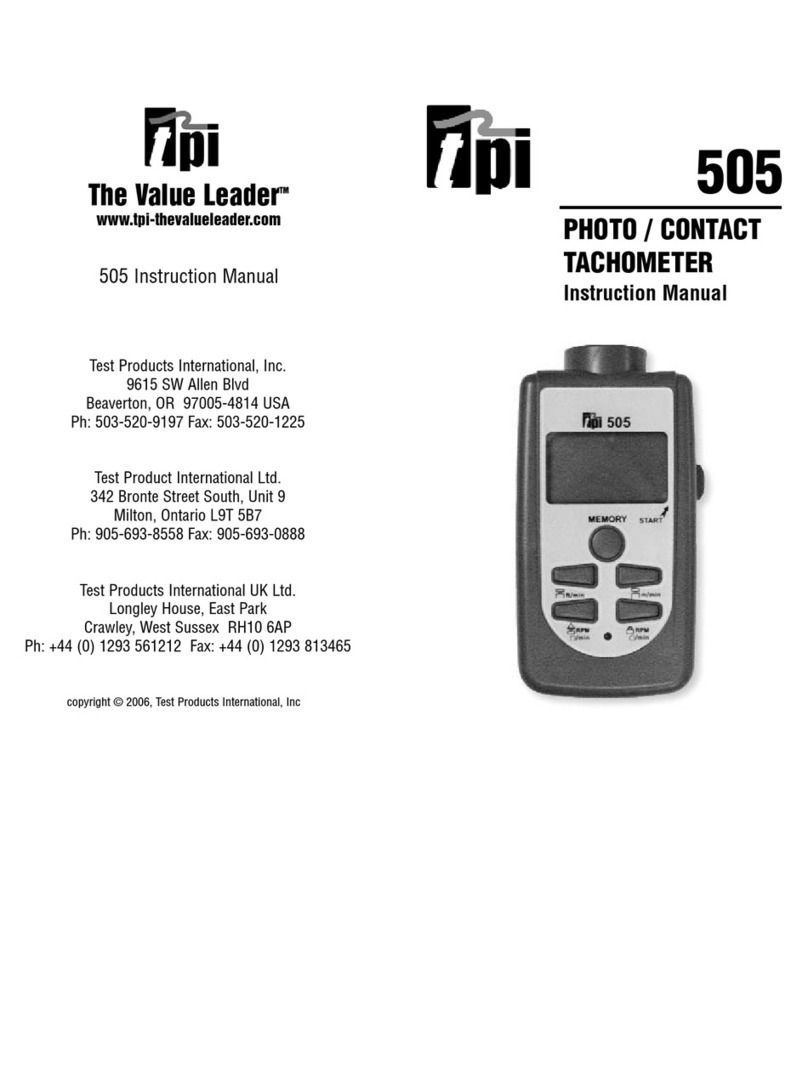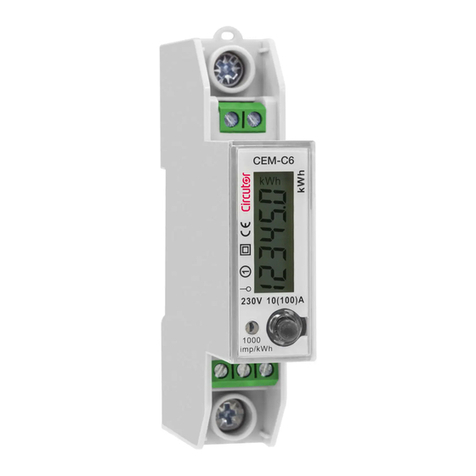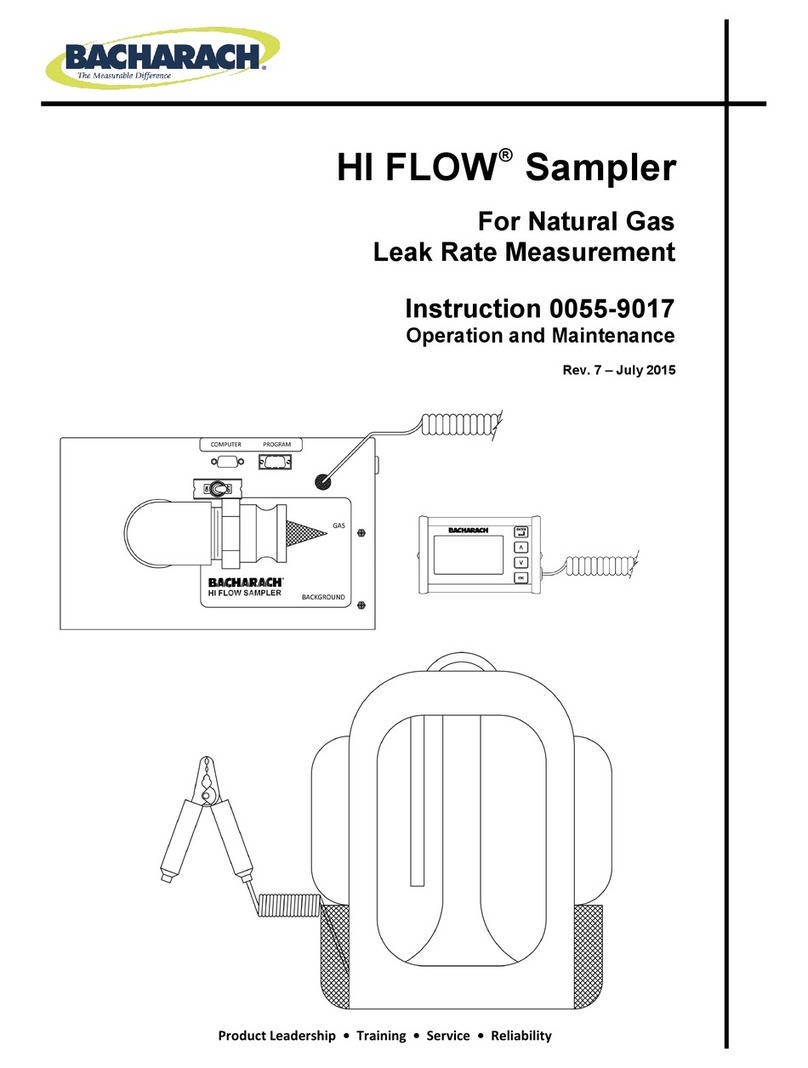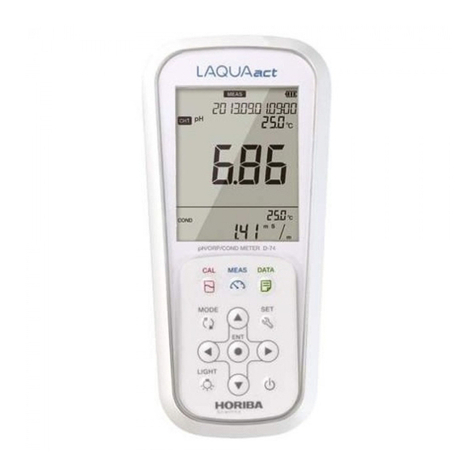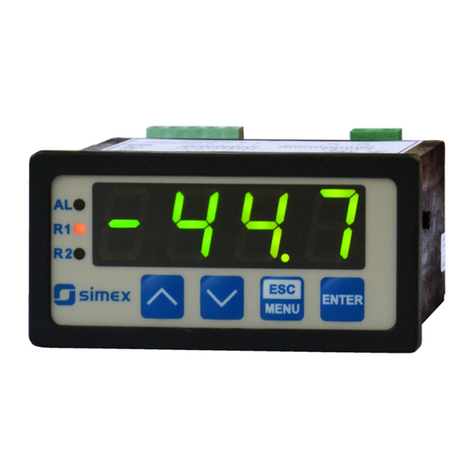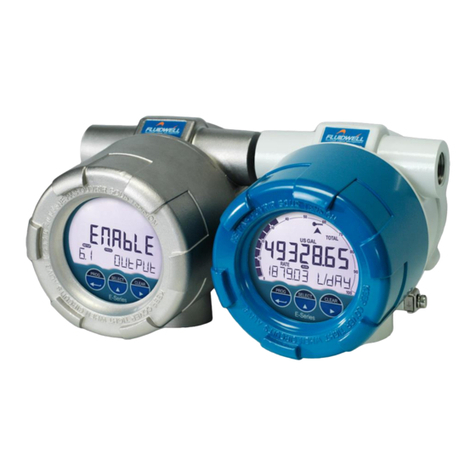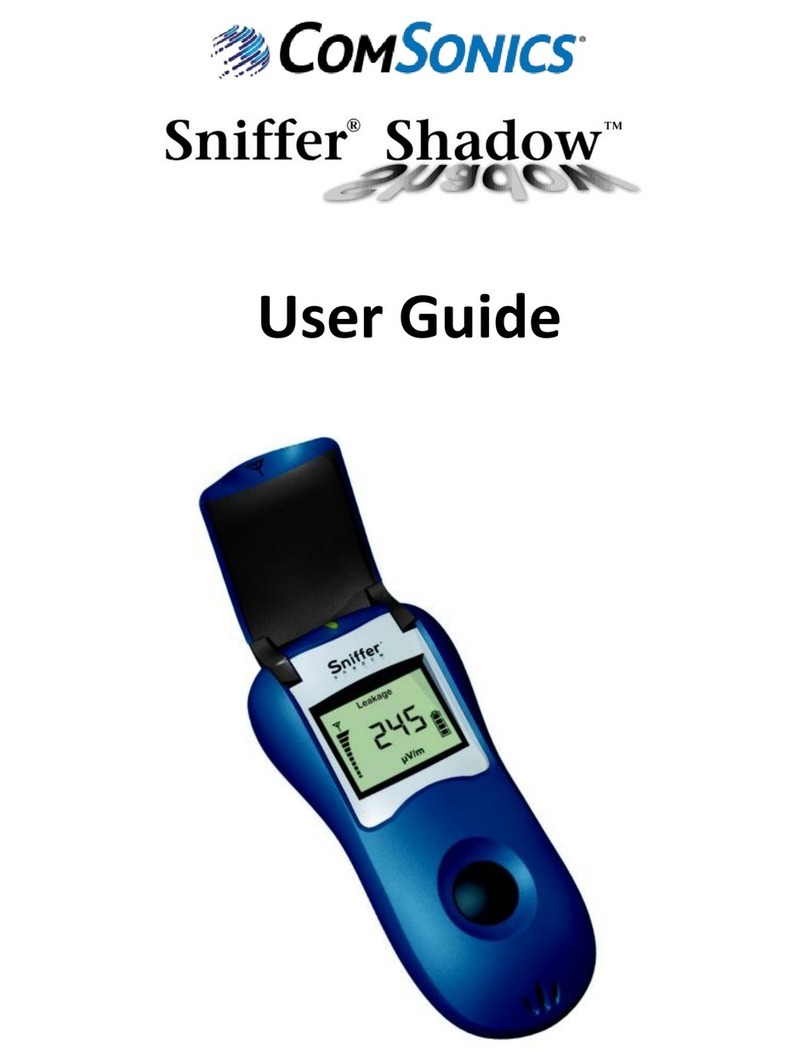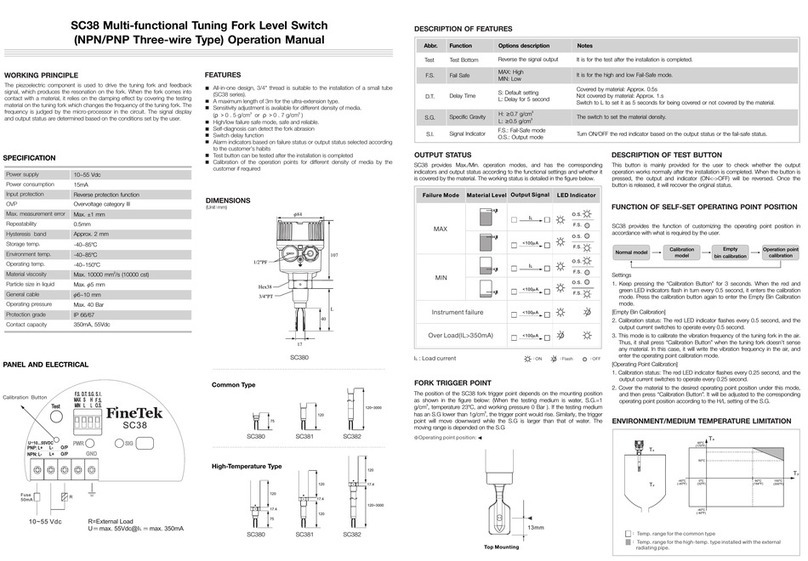ILX Lightwave FPM-8200 User manual

User’s Guide
Fiber Optic Power Meter
FPM-8200
ILX Lightwave Corporation · P. O. Box 6310 · Bozeman, MT, U.S.A. 59771 · U.S. & Canada: 1-800-459-9459 · International Inquiries: 406-556-2481 · Fax 406-586-9405
ilx.custhelp.com ·www.ilxlightwave.com
70034601 January 2010


FPM-8200 i
TABLE OF CONTENTS
Table of Contents . . . . . . . . . . . . . . . . . . . . . . . . . . . . . . . . . . . . . . . . . . . . . . . . . i
List of Figures. . . . . . . . . . . . . . . . . . . . . . . . . . . . . . . . . . . . . . . . . . . . . . . . . . . . v
List of Tables. . . . . . . . . . . . . . . . . . . . . . . . . . . . . . . . . . . . . . . . . . . . . . . . . . . . vii
Safety and Warranty Information . . . . . . . . . . . . . . . . . . . . . . . . . . . . . . . . . . . ix
Safety Information and the Manual . . . . . . . . . . . . . . . . . . . . . . . . . . . . . . . . . ix
General Safety Considerations . . . . . . . . . . . . . . . . . . . . . . . . . . . . . . . . . . . . ix
Safety Symbols. . . . . . . . . . . . . . . . . . . . . . . . . . . . . . . . . . . . . . . . . . . . . . . . . . . x
Safety Marking Symbols . . . . . . . . . . . . . . . . . . . . . . . . . . . . . . . . . . . . . . . . . x
Warranty . . . . . . . . . . . . . . . . . . . . . . . . . . . . . . . . . . . . . . . . . . . . . . . . . . . . . . . xi
Limitations . . . . . . . . . . . . . . . . . . . . . . . . . . . . . . . . . . . . . . . . . . . . . . . . xi
Returning an Instrument . . . . . . . . . . . . . . . . . . . . . . . . . . . . . . . . . . . . . . xi
Claims for Shipping Damage . . . . . . . . . . . . . . . . . . . . . . . . . . . . . . . . . . xi
Comments, Suggestions, and Problems . . . . . . . . . . . . . . . . . . . . . . . . . . . .xii
In the United States: . . . . . . . . . . . . . . . . . . . . . . . . . . . . . . . . . . . . . . . . .xii
In Europe: . . . . . . . . . . . . . . . . . . . . . . . . . . . . . . . . . . . . . . . . . . . . . . . . .xii
In Japan: . . . . . . . . . . . . . . . . . . . . . . . . . . . . . . . . . . . . . . . . . . . . . . . . . .xii
In China: . . . . . . . . . . . . . . . . . . . . . . . . . . . . . . . . . . . . . . . . . . . . . . . . . .xii
In China: . . . . . . . . . . . . . . . . . . . . . . . . . . . . . . . . . . . . . . . . . . . . . . . . . .xii
Chapter 1 Introduction and Specifications
Product Overview . . . . . . . . . . . . . . . . . . . . . . . . . . . . . . . . . . . . . . . . . . . . . . . . 1
Specifications . . . . . . . . . . . . . . . . . . . . . . . . . . . . . . . . . . . . . . . . . . . . . . . . . . . 2
AC Power . . . . . . . . . . . . . . . . . . . . . . . . . . . . . . . . . . . . . . . . . . . . . . . . . . . 2
Tilt-Foot Adjustment . . . . . . . . . . . . . . . . . . . . . . . . . . . . . . . . . . . . . . . . . . . 2
Rack Mounting . . . . . . . . . . . . . . . . . . . . . . . . . . . . . . . . . . . . . . . . . . . . . . . 2
Power-Up Sequence . . . . . . . . . . . . . . . . . . . . . . . . . . . . . . . . . . . . . . . . . . 2
Default Configuration . . . . . . . . . . . . . . . . . . . . . . . . . . . . . . . . . . . . . . . . 3

TABLE OF CONTENTS
ii FPM-8200
Chapter 2 Front Panel Operation
The FPM-8200 Front Panel . . . . . . . . . . . . . . . . . . . . . . . . . . . . . . . . . . . . . . . . . 5
Front Panel Familiarization . . . . . . . . . . . . . . . . . . . . . . . . . . . . . . . . . . . . . . . 6
Power On/Off . . . . . . . . . . . . . . . . . . . . . . . . . . . . . . . . . . . . . . . . . . . . . . . . 6
GPIB Control . . . . . . . . . . . . . . . . . . . . . . . . . . . . . . . . . . . . . . . . . . . . . . . . 6
Mode Control . . . . . . . . . . . . . . . . . . . . . . . . . . . . . . . . . . . . . . . . . . . . . . . . 6
Parameter Setup Control . . . . . . . . . . . . . . . . . . . . . . . . . . . . . . . . . . . . . 7
Gain Ranges . . . . . . . . . . . . . . . . . . . . . . . . . . . . . . . . . . . . . . . . . . . . . . 7
Gain Range Display . . . . . . . . . . . . . . . . . . . . . . . . . . . . . . . . . . . . . . . . . 7
Wavelength . . . . . . . . . . . . . . . . . . . . . . . . . . . . . . . . . . . . . . . . . . . . . . . 8
Save and Recall . . . . . . . . . . . . . . . . . . . . . . . . . . . . . . . . . . . . . . . . . . . . 8
Zero . . . . . . . . . . . . . . . . . . . . . . . . . . . . . . . . . . . . . . . . . . . . . . . . . . . . . 9
Filter Control . . . . . . . . . . . . . . . . . . . . . . . . . . . . . . . . . . . . . . . . . . . . . . . 10
Bar Graph Display . . . . . . . . . . . . . . . . . . . . . . . . . . . . . . . . . . . . . . . . . . . 11
User Calibration . . . . . . . . . . . . . . . . . . . . . . . . . . . . . . . . . . . . . . . . . . . . . . 11
Linear Power Mode Display . . . . . . . . . . . . . . . . . . . . . . . . . . . . . . . . . . . . . 12
The FPM-8200 Back Panel . . . . . . . . . . . . . . . . . . . . . . . . . . . . . . . . . . . . . . . . 13
GPIB Connector . . . . . . . . . . . . . . . . . . . . . . . . . . . . . . . . . . . . . . . . . . . . . 13
AC Line Power Input . . . . . . . . . . . . . . . . . . . . . . . . . . . . . . . . . . . . . . . . . 13
Chassis Ground . . . . . . . . . . . . . . . . . . . . . . . . . . . . . . . . . . . . . . . . . . . . . 14
Analog Output (BNC) . . . . . . . . . . . . . . . . . . . . . . . . . . . . . . . . . . . . . . . . . 14
Gain Range Boundaries . . . . . . . . . . . . . . . . . . . . . . . . . . . . . . . . . . . . . 14
Determining Range . . . . . . . . . . . . . . . . . . . . . . . . . . . . . . . . . . . . . . . . 15
Relating Optical Power to Analog Voltage . . . . . . . . . . . . . . . . . . . . . . . 16
Operating Guidelines . . . . . . . . . . . . . . . . . . . . . . . . . . . . . . . . . . . . . . . . . . . . 17
Warm-up and Environmental Considerations . . . . . . . . . . . . . . . . . . . . . . 17
Summary of Operating Procedures . . . . . . . . . . . . . . . . . . . . . . . . . . . . . . 17
Measuring Higher Power . . . . . . . . . . . . . . . . . . . . . . . . . . . . . . . . . . . . . . 17
Understanding the Calibration Certificate . . . . . . . . . . . . . . . . . . . . . . . . . 19
Photodetector Responsivity . . . . . . . . . . . . . . . . . . . . . . . . . . . . . . . . . . 19
Chapter 3 Remote Operation
Basic GPIB Concepts . . . . . . . . . . . . . . . . . . . . . . . . . . . . . . . . . . . . . . . . . . . . 22
Data and Interface Messages . . . . . . . . . . . . . . . . . . . . . . . . . . . . . . . . . . 22
Talkers, Listeners, and Controllers . . . . . . . . . . . . . . . . . . . . . . . . . . . . . 22
GPIB Cable Connections . . . . . . . . . . . . . . . . . . . . . . . . . . . . . . . . . . . . 23
The GPIB Connector . . . . . . . . . . . . . . . . . . . . . . . . . . . . . . . . . . . . . . . 23
Configuring the GPIB Controller . . . . . . . . . . . . . . . . . . . . . . . . . . . . . . . . . . 24
Changing Operation from Local to Remote . . . . . . . . . . . . . . . . . . . . . . . . 24
Setting the GPIB Address . . . . . . . . . . . . . . . . . . . . . . . . . . . . . . . . . . . . . 25
Command Syntax . . . . . . . . . . . . . . . . . . . . . . . . . . . . . . . . . . . . . . . . . . . . . . . 26

TABLE OF CONTENTS
01_10 FPM-8200 iii
Letters . . . . . . . . . . . . . . . . . . . . . . . . . . . . . . . . . . . . . . . . . . . . . . . . . . . . 26
White Space . . . . . . . . . . . . . . . . . . . . . . . . . . . . . . . . . . . . . . . . . . . . . . . 26
Terminators . . . . . . . . . . . . . . . . . . . . . . . . . . . . . . . . . . . . . . . . . . . . . . . . 27
Command Separators . . . . . . . . . . . . . . . . . . . . . . . . . . . . . . . . . . . . . . . . 27
Parameters . . . . . . . . . . . . . . . . . . . . . . . . . . . . . . . . . . . . . . . . . . . . . . . . 28
Command Tree Structure . . . . . . . . . . . . . . . . . . . . . . . . . . . . . . . . . . . . . 28
Syntax Summary . . . . . . . . . . . . . . . . . . . . . . . . . . . . . . . . . . . . . . . . . . . . 29
Internal Registers . . . . . . . . . . . . . . . . . . . . . . . . . . . . . . . . . . . . . . . . . . . . . . . 31
Concepts . . . . . . . . . . . . . . . . . . . . . . . . . . . . . . . . . . . . . . . . . . . . . . . . . . 31
Register Structure and Contents . . . . . . . . . . . . . . . . . . . . . . . . . . . . . . . . . 32
Standard Event Status Register Pair . . . . . . . . . . . . . . . . . . . . . . . . . . . 32
Event Status Register Pair Contents . . . . . . . . . . . . . . . . . . . . . . . . . . . 33
Condition Status Register Pair . . . . . . . . . . . . . . . . . . . . . . . . . . . . . . . . 34
Status Byte and Service Request Enable Register Pair . . . . . . . . . . . . . 35
Command Timing . . . . . . . . . . . . . . . . . . . . . . . . . . . . . . . . . . . . . . . . . . . . . . . 36
Sequential/Overlapped Commands . . . . . . . . . . . . . . . . . . . . . . . . . . . . . . 36
Query Response Timing . . . . . . . . . . . . . . . . . . . . . . . . . . . . . . . . . . . . . . 36
Input/Output Buffer . . . . . . . . . . . . . . . . . . . . . . . . . . . . . . . . . . . . . . . . . . . . 36
Interface Messages . . . . . . . . . . . . . . . . . . . . . . . . . . . . . . . . . . . . . . . . . . . . . . 37
Interface Function Subsets . . . . . . . . . . . . . . . . . . . . . . . . . . . . . . . . . . . . . . 37
Recovering From a “Bus-Hung” Condition . . . . . . . . . . . . . . . . . . . . . . . 37
Remote Messages . . . . . . . . . . . . . . . . . . . . . . . . . . . . . . . . . . . . . . . . . . . 37
Chapter 4 GPIB Command Reference
Command Types . . . . . . . . . . . . . . . . . . . . . . . . . . . . . . . . . . . . . . . . . . . . . . . . 39
Notes on Syntax . . . . . . . . . . . . . . . . . . . . . . . . . . . . . . . . . . . . . . . . . . . . . . . . 40
Required and Optional Letters . . . . . . . . . . . . . . . . . . . . . . . . . . . . . . . . . . . 40
White Space . . . . . . . . . . . . . . . . . . . . . . . . . . . . . . . . . . . . . . . . . . . . . . . 40
Terminator String . . . . . . . . . . . . . . . . . . . . . . . . . . . . . . . . . . . . . . . . . . . . 40
Multiple Commands . . . . . . . . . . . . . . . . . . . . . . . . . . . . . . . . . . . . . . . . . . 40
Numeric Parameters . . . . . . . . . . . . . . . . . . . . . . . . . . . . . . . . . . . . . . . . . 40
GPIB Command Reference Summary . . . . . . . . . . . . . . . . . . . . . . . . . . . . . . . 41
GPIB Command Reference . . . . . . . . . . . . . . . . . . . . . . . . . . . . . . . . . . . . . . . . 44
Chapter 5 Troubleshooting and Maintenance
Troubleshooting Guide . . . . . . . . . . . . . . . . . . . . . . . . . . . . . . . . . . . . . . . . . . . 68
Front Panel Problems . . . . . . . . . . . . . . . . . . . . . . . . . . . . . . . . . . . . . . . . 68
GPIB Problems . . . . . . . . . . . . . . . . . . . . . . . . . . . . . . . . . . . . . . . . . . . . . 69
Optical Measurement Problems . . . . . . . . . . . . . . . . . . . . . . . . . . . . . . . . 70

TABLE OF CONTENTS
iv FPM-8200
Line Voltage Setting . . . . . . . . . . . . . . . . . . . . . . . . . . . . . . . . . . . . . . . . . . . 70
Error Messages . . . . . . . . . . . . . . . . . . . . . . . . . . . . . . . . . . . . . . . . . . . . . . . . . 71
Error Code Tables . . . . . . . . . . . . . . . . . . . . . . . . . . . . . . . . . . . . . . . . . . . . 71
Appendix A Conversion Tables
Decibel to Percentage Conversion . . . . . . . . . . . . . . . . . . . . . . . . . . . . . . 76
dBm to Watts Conversion . . . . . . . . . . . . . . . . . . . . . . . . . . . . . . . . . . . . . 77
Wavelength to Frequency Conversion . . . . . . . . . . . . . . . . . . . . . . . . . . . . 78
Linewidth Conversions . . . . . . . . . . . . . . . . . . . . . . . . . . . . . . . . . . . . . . . . 79

FPM-8200 v
LIST OF FIGURES
Figure 2.1 FPM-8200 Front Panel . . . . . . . . . . . . . . . . . . . . . . . . . . . . . . . . 5
Figure 2.2 Parameter Setup Front Panel Controls . . . . . . . . . . . . . . . . . . . . 7
Figure 2.3 Bar Graph . . . . . . . . . . . . . . . . . . . . . . . . . . . . . . . . . . . . . . . . . 11
Figure 2.4 FPM-8200 Back Panel . . . . . . . . . . . . . . . . . . . . . . . . . . . . . . . . 13
Figure 3.1 GPIB Cable Connections . . . . . . . . . . . . . . . . . . . . . . . . . . . . . . 23
Figure 3.2 GPIB Connector Diagram . . . . . . . . . . . . . . . . . . . . . . . . . . . . . 24
Figure 3.3 Command Tree Structure . . . . . . . . . . . . . . . . . . . . . . . . . . . . . 29
Figure 3.4 Enable Registers . . . . . . . . . . . . . . . . . . . . . . . . . . . . . . . . . . . . 31
Figure 3.5 Standard Event Status . . . . . . . . . . . . . . . . . . . . . . . . . . . . . . . . 32
Figure 3.6 Event Status Register Pair . . . . . . . . . . . . . . . . . . . . . . . . . . . . . 33
Figure 3.7 Condition Status Register Pair . . . . . . . . . . . . . . . . . . . . . . . . . . 34
Figure 3.8 Service Request Enable Register . . . . . . . . . . . . . . . . . . . . . . . 35

LIST OF FIGURES
vi FPM-8200

FPM-8200 vii
LIST OF TABLES
Table 1.1 FPM-8200 Fiber Power Meters Specifications . . . . . . . . . . . . . . . . 4
Table 2.1 Gain Range Boundaries . . . . . . . . . . . . . . . . . . . . . . . . . . . . . . . . 14
Table 3.1 ANSI/IEEE-488 Terminology . . . . . . . . . . . . . . . . . . . . . . . . . . . . 26
Table 3.2 Invalid Syntax Command Strings . . . . . . . . . . . . . . . . . . . . . . . . . 30
Table 4.1 Syntax Error Examples. . . . . . . . . . . . . . . . . . . . . . . . . . . . . . . . . 41
Table 4.2 GPIB Summary Reference Command List. . . . . . . . . . . . . . . . . . 41
Table 5.1 Internal Errors. . . . . . . . . . . . . . . . . . . . . . . . . . . . . . . . . . . . . . . . 71
Table 5.2 Parser Errors . . . . . . . . . . . . . . . . . . . . . . . . . . . . . . . . . . . . . . . . 71
Table 5.3 Execution Control Errors. . . . . . . . . . . . . . . . . . . . . . . . . . . . . . . . 72
Table 5.4 GPIB Errors . . . . . . . . . . . . . . . . . . . . . . . . . . . . . . . . . . . . . . . . . 72
Table 5.5 Operation Errors. . . . . . . . . . . . . . . . . . . . . . . . . . . . . . . . . . . . . . 73
Table 5.6 Hardware Errors . . . . . . . . . . . . . . . . . . . . . . . . . . . . . . . . . . . . . . 73
Table A.1 Decibel to Percentage . . . . . . . . . . . . . . . . . . . . . . . . . . . . . . . . . 76
Table A.2 dBm to Watts . . . . . . . . . . . . . . . . . . . . . . . . . . . . . . . . . . . . . . . . 77
Table A.3 Wavelength to Frequency . . . . . . . . . . . . . . . . . . . . . . . . . . . . . . 78
Table A.4 Linewidth Conversions. . . . . . . . . . . . . . . . . . . . . . . . . . . . . . . . . 79

LIST OF TABLES
viii FPM-8200

FPM-8200 ix
S
AFETY
AND
W
ARRANTY
I
NFORMATION
The Safety and Warranty Information section provides details about cautionary symbols used in the
manual, safety markings used on the instrument, and information about the Warranty including
Customer Service contact information.
Safety Information and the Manual
Throughout this manual, you will see the words Caution and Warning indicating potentially
dangerous or hazardous situations which, if not avoided, could result in death, serious or minor
injury, or damage to the product. Specifically:
!
CAUTION
Caution indicates a potentially hazardous situation which can result in minor or
moderate injury or damage to the product or equipment.
WARNING
Warning indicates a potentially dangerous situation which can result in serious injury or
death.
WARNING
Visible and/or invisible laser radiation. Avoid direct exposure to the beam.
General Safety Considerations
If any of the following conditions exist, or are even suspected, do not use the instrument until safe
operation can be verified by trained service personnel:
•Visible damage
•Severe transport stress
•Prolonged storage under adverse conditions
•Failure to perform intended measurements or functions
If necessary, return the instrument to ILX Lightwave, or authorized local ILX Lightwave distributor, for
service or repair to ensure that safety features are maintained (see the contact information on page
xii).
All instruments returned to ILX Lightwave are required to have a Return Authorization Number
assigned by an official representative of ILX Lightwave Corporation. See Returning an Instrument on
page xi for more information.

SAFETY SYMBOLS
x FPM-8200
S
AFETY
S
YMBOLS
This section describes the safety symbols and classifications.
Technical specifications including electrical ratings and weight are included within the manual. See
the Table of Contents to locate the specifications and other product information. The following
classifications are standard across all ILX Lightwave products:
•Indoor use only
•Ordinary Protection: This product is NOT protected against the harmful ingress of moisture.
•Class I Equipment (grounded type)
•Pollution Degree II
•Installation (overvoltage) Category II for transient overvoltages
•Maximum Relative Humidity: <80% RH, non-condensing
•Operating temperature range of 0 oC to 40 oC
•Storage and transportation temperature of -40 oC to 70 oC
•Maximum altitude: 3000 m (9843 ft)
•This equipment is suitable for continuous operation.
Safety Marking Symbols
This section provides a description of the safety marking symbols that appear on the instrument.
These symbols provide information about potentially dangerous situations which can result in death,
injury, or damage to the instrument and other components.
Caution,
refer to
manual
Earth
ground
Terminal
Alternating
current
Visible and/or
invisible laser
radiation
Caution, risk
of electric
shock
Protective
Conductor
Terminal
Caution, hot
surface
Frame or
chassis
Terminal
On: In position of a bistable push control. The
slash (I) only denotes that mains are on.
Off: Out position of a bistable push control.
The circle (O) only denotes that mains are off.
or
(I)
or
(O)

WAR RANTY
FPM-8200 xi
W
ARRANTY
ILX LIGHTWAVE CORPORATION warrants this instrument to be free from defects in material and
workmanship for a period of one year from date of shipment. During the warranty period, ILX will
repair or replace the unit, at our option, without charge.
Limitations
This warranty does not apply to fuses, lamps, defects caused by abuse, modifications, or to use of
the product for which it was not intended.
This warranty is in lieu of all other warranties, expressed or implied, including any implied warranty
of merchantability or fitness for any particular purpose. ILX Lightwave Corporation shall not be liable
for any incidental, special, or consequential damages.
If a problem occurs, please contact ILX Lightwave Corporation with the instrument's serial number,
and thoroughly describe the nature of the problem.
Returning an Instrument
If an instrument is to be shipped to ILX Lightwave for repair or service, be sure to:
1Obtain a Return Authorization number (RA) from ILX Customer Service.
2Attach a tag to the instrument identifying the owner and indicating the required service or
repair. Include the instrument serial number from the rear panel of the instrument.
3Attach the anti-static protective caps that were shipped with the instrument and place the
instrument in a protective anti-static bag.
4Place the instrument in the original packing container with at least 3 inches (7. 5 cm) of
compressible packaging material. Shipping damage is not covered by this warranty.
5Secure the packing box with fiber reinforced strapping tape or metal bands.
6Send the instrument, transportation pre-paid, to ILX Lightwave. Clearly write the return
authorization number on the outside of the box and on the shipping paperwork. ILX
Lightwave recommends you insure the shipment.
If the original shipping container is not available, place your instrument in a container with at least 3
inches (7.5 cm) of compressible packaging material on all sides.
Repairs are made and the instrument returned transportation pre-paid. Repairs are warranted for the
remainder of the original warranty or for 90 days, whichever is greater.
Claims for Shipping Damage
When you receive the instrument, inspect it immediately for any damage or shortages on the
packing list. If the instrument is damaged, file a claim with the carrier. The factory will supply you with
a quotation for estimated costs of repair. You must negotiate and settle with the carrier for the
amount of damage.

WAR RANTY
xii FPM-8200
Comments, Suggestions, and Problems
To ensure that you get the most out of your ILX Lightwave product, we ask that
you direct any product operation or service related questions or comments to ILX
Lightwave Customer Support. You may contact us in whatever way is most
convenient.
In the United States:
Phone . . . . . . . . . . . . . . . . . . . . . . . . . . . (800) 459-9459 or (406) 586-1244
Fax . . . . . . . . . . . . . . . . . . . . . . . . . . . . . . . . . . . . . . . . . . . . . (406) 586-9405
Online: . . . . . . . . . . . . . . . . . . . . . . . . . . . . . . . . . . . . . http://ilx.custhelp.com
Or mail to:
ILX Lightwave Corporation
P. O. Box 6310
Bozeman, Montana, U.S.A 59771
www.ilxlightwave.com
In Europe: In Japan:
Optical Test and Calibration Ltd.
Listerhills Science Park
Bradford, BD7 1HR United Kingdom
Phone: (44) 1274 393857
Fax: (44) 1274 393336
Online: www.otc.co.uk
Email: [email protected]
Kyosai Technos
424, Shimo-Ongata-Machi
Hachioji-Shi
Tokyo, 192-0154 Japan
Phone: (81) 426 521 388
Fax: (81) 426 513 270
In China: In China:
ETSC Technologies Co.
9/F Building 1
SBI Street
Dongxin Road
East Lake High-Tech Development Zone
Wuhan, Hubei, 430074 PRC China
Phone: (86) 27 8717 0152; (86) 27 8741
2681; (86) 27 8780 7925
Fax: (86) 27 8780 7133
Online: www.etsc-tech.com
Email: [email protected]
Kyosai Technos
3F Bldg G, No.21 Changjiang Road, Wuxi
National Hi-Tech Development Zone
Jiangsu, P.R. China
Phone: (86) 510 522 1707
Fax: (86) 510 522 1679
Email: [email protected]

WAR RANTY
FPM-8200 xiii
When you contact us, please have the following information:
If ILX Lightwave determines that a return to the factory is necessary, you are
issued a Return Authorization (RA) number. Please mark this number on the
outside of the shipping box.
You or your shipping service are responsible for any shipping damage when
returning the instrument to ILX Lightwave; ILX recommends you insure the
shipment. If the original shipping container is not available, place your instrument
in a container with at least 3 inches (7.5 cm) of compressible packaging material
on all sides.
We look forward to serving you even better in the future!
Model Number:
Serial Number:
End-user Name:
Company:
Phone:
Fax:
Description of what is
connected to the ILX
Lightwave instrument:
Description of the problem:

WAR RANTY
xiv FPM-8200

FPM-8200 1
CHAPTER 1
INTRODUCTION AND SPECIFICATIONS
This chapter introduces the FPM-8200 Fiber Optic Power Meter with an overview
description. Also included are a list of available accessories to extend the
usefulness of your meter, installation instructions, a description of the start-up
sequence, and specifications.
Product Overview
The FPM-8200 is a precision, systems-capable fiber optic power meter that
provides optical power measurement from 800 to 1600 nm. The 8200 features 75
dB of dynamic range and NIST-traceable calibration. Maximum instrument
flexibility is achieved with digital averaging, Save and Recall functions, and a
unique LED bar graph that displays relative power as a percent of full scale for
each gain range. The FPM-8200 offers standard Analog output ports and a
sophisticated GPIB/IEEE interface. Other features include:
•Average up to 100 measurements per reading for accuracy with unstable inputs
•SAVE and RECALL up to ten of your test setups
•Bargraph displays relative power for visual peaking of optical setups
•0-10 V analog output for fine resolution relative power monitoring

INTRODUCTION AND SPECIFICATIONS
Specifications
2 FPM-8200
CHAPTER 1
Specifications
This section discusses AC power considerations, tilt-foot adjustment, rack
mounting, and describes the power up sequence.
AC Power
To avoid electrical shock hazard, connect the FPM-8200 only to a properly earth-
grounded receptacle. Failure to observe this precaution can result in severe injury or
death.
The FPM-8200 is factory configured for operation at nominal line voltages of 100,
120, 220, or 240 VAC. Make sure the voltage printed on the back panel of the
instrument matches the power-line voltage in your area. Contact ILX Lightwave
Customer Service if you need to reconfigure the input voltage range.
Tilt-Foot Adjustment
The FPM-8200 has front legs that extend to make it easier to view the displays. To
use them, rotate the legs downward until they lock into position.
Rack Mounting
The FPM-8200 conforms to international standards for a 2U-height 1/2-width rack
mounting. The available rack mount accessory kits contain detailed mounting
instructions.
Power-Up Sequence
With the FPM-8200 connected to an AC power source, pressing POWER supplies
AC line power to the instrument and starts the following power-up sequence:
•All front panel indicators ON, all 7-segment displays indicate "8".
•All front panel indicators OFF.
•Display shows the internal firmware version number.
Each display lasts 2-3 seconds. During the front panel indicator test, the FPM-8200
performs a self-test to ensure that internal hardware and software are communicating. After
the self test, FPM-8200 configuration is set to the same state as when power was last
turned off. You can then use the recall function to quickly get to a different setup. See Save
and Recall on page 8. for more information. If the instrument cannot successfully complete
the test, an error message is displayed. See Error Messages on page 71 for a complete list
of error messages.

INTRODUCTION AND SPECIFICATIONS
Specifications
01_10 FPM-8200 3
CHAPTER 1
Default Configuration
•GPIB mode in LOCAL via front panel, or in REMOTE via GPIB
•MODE = W (Watts)
•displays show measured power and set wavelength
•(Wavelength) = 1300 nm
•Measurement FILTER is set to MEDIUM
•RANGE is in MANUAL, lowest gain (10 mA maximum detector current)
•SET REF (for dB) = 0.0000 dBm
•USER CAL = 1.000 (indicator off)
•ZERO is off
•RECALL BIN number = 0

INTRODUCTION AND SPECIFICATIONS
Specifications
4 FPM-8200
CHAPTER 1
Table 1.1 FPM-8200 Fiber Power Meters Specifications
Wavelength range 800-1600 nm
Power range1
1. Minimum Power −70 dBm for=800˘1000 nm. Power range limits defined by linearity specification at NA=0.11, (eg SMF−28 fiber).
Maximum power linearity limit is higher for wider NA fiber.
-75 to +1.5 dBm
Damage Threshold +10 dBm
Accuracy 2
Reference conditions3
Operating conditions4
2. Valid across power range limits from 1000–1600 nm. Includes traceability to NIST. Calibrated at 23°C ±3°C, at 10 nm intervals.
Uncertainty evaluated according to NIST Technical Note #1297: "Guidelines for Evaluating and Expressing the Uncertainty of NIST
Measurement Results".
3. Temperature 23±2 ºC, 1000–1600 nm, spot diameter 1.1mm, power -20 dBm (10µW).
4. Conditions: Temperature 0–40 °C, 1000–1600 nm, fiber NA 0.3.
±2.5%
±5.0%
Sensor type InGaAs
Noise5
5. Measured over 1 minute, in medium filter mode.
2.0 pW (p-p) (1000-1600 nm)
<4.0 pW (p-p) (800-1000 nm)
Sample rate6
6. GPIB data transfer rate is faster than measurement sample rate.
50 msec
Temperature coefficient Typical ±0.2%/oC
Linearity7
7. Total variation from straight−line response. Valid across power range measurment limits if measured in auto−range mode. Measured
at 23 ±2 °C.
±0.015 dB, ±2 pW
Power display
Type
Resolution
-80 to +5 dBm
5-digit, 7-segment LED, log or linear mode
0.001 unit (log or linear)
Wavelength display (input)
Type
Range
Resolution
4-digit, 7-segment LED
800–1600 nm
1 nm
Power level bargraph
Type
Range
Resolution
LED Bar Graph
Relative to full scale
<0.05 dB
Display Filter Update Rate8
Slow˙100 measurements
Medium˙10 measurements
Fast˙1 measurement
8. Valid across power range limits from 1000–1600 nm. Includes traceability to NIST. Calibrated at 23°C ±3°C, at 10 nm intervals.
Uncertainty evaluated according to NIST Technical Note #1297: "Guidelines for Evaluating and Expressing the Uncertainty of NIST
Measurement Results".
5.0 s
0.50 s
0.05 s
Analog output (rear panel)
Bandwidth
Voltage
Impedance
Typical 0–10 Hz
0–10V
Typical 1000
Compatible Connector Types9
9. Valid across power range limits from 1000–1600 nm. Includes traceability to NIST. Calibrated at 23°C ±3°C, at 10 nm intervals.
Uncertainty evaluated according to NIST Technical Note #1297: "Guidelines for Evaluating and Expressing the Uncertainty of NIST
Measurement Results".
FC/PC, FC/APC, LC, SC, ST, DIN, BARE FIBER
Environment
Operating temperature
Storage temperature
Humidity
Line voltage
Line frequency
10 ×–40 oC
-40 ×C to +70 oC
<85% RH, non-condensing
100V ±10%, 120V ±10%, 220V ±10%, 230-240V ±10%
50ó60 Hz
General
Size
Weight 88 x 212 x 270 mm (3.5 x 8.4x 10.6 inches)
4.4 kg, 9.7 lb
Table of contents
Other ILX Lightwave Measuring Instrument manuals
